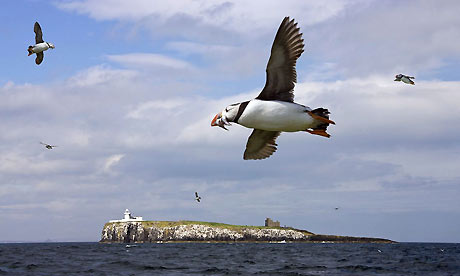National Trust warns of losing battle to save much-loved coastal landmarks from rising sea levels and erosion
- The Observer,
- Sunday August 24 2008

Farne Islands, Northumberland. Photograph: Steve Allen Travel Photography/Getty Images
Some of Britain's most famous coastal landmarks will be radically changed or even lost because it is no longer possible to hold back rising seas and coastal erosion, according to the National Trust.
The castle of St Michael's Mount off the coast of Cornwall, the white cliffs of Birling Gap in East Sussex, Studland beach in Dorset and the dunes of Formby, near Liverpool, are among the places which could alter dramatically. In one of the most extreme cases to be identified by the trust, the entire 18th-century fishing village of Porthdinllaen on the north-west coast of Wales could be left to crumble into the sea.
The report on the 10 coastal hotspots will be published this week to highlight the problems of climate change which threaten about 70 sites around the coastline owned by the trust.
Phil Dyke, the National Trust's coast and marine adviser, said the decision to stop protecting many coastal areas was driven by the rising cost of damage, because global warming is causing more sea-level rises and more intense storms which exacerbate erosion, and because protection measures often cause damage farther along the coast, for example, depriving nearby beaches of shingle and sand. On one site in Cornwall the trust estimated it would cost £6m to build defences which would only last about 25 years.
The report highlights the difficult decisions which will have to be taken across Britain and around the world as landowners and governments decide how to cope with the impact of climate change on habitats and built infrastructure, particularly after a tradition of pitting engineers against natural change.
'Over the next 100 years the shape of our coastline will change, and our favourite seaside destinations may not look the way they were captured in our holiday snapshots,' said Dyke. 'I think we have a natural affinity with our coast and the sea. But we all need to be aware that our environment is not fixed and that change is inevitable.'
Three years ago a separate report by the National Trust warned that more than half the charity's coastline was under threat and up to 10,000 acres could be lost to the sea in the next century, but the full impact of the problem had not been fully appreciated.
The 10 case studies in the report include three residential areas: at Birling Gap in Sussex one cottage has already been demolished and the remaining four will eventually be lost as the soft chalk cliffs erode by a metre a year; residents on St Michael's Mount, near Penzance, could lose their low-tide causeway permanently and have to move to homes higher above the tide-line; and the 16 houses and inn of Porthdinllaen on the Lleyn peninsula are likely to be lost because more stormy weather will bring more flooding and landslides, says the trust.
Other risk areas identified are the puffin and seal colonies on the Farne Islands off the Northumberland coast; the shingle spit of East Head at the entrance to Chichester Harbour in West Sussex, which will also affect nearby West Wittering beach; Dorset's Studland beach, which is visited by more than one million people a year; the dune system of Formby, near Liverpool; the shingle spit and marshes of Blakeney national nature reserve in Norfolk; the sweeping sands of Rhossili on the Gower peninsula in Wales where a sand-covered medieval village is also being lost to the sea; and Northern Ireland's Portstewart Strand beach and dunes.
In many cases the trust is investing in visitor centres and paths to keep access to the coast, but Dyke said that the trust wanted government to do more to help affected communities, especially property owners.

No comments:
Post a Comment